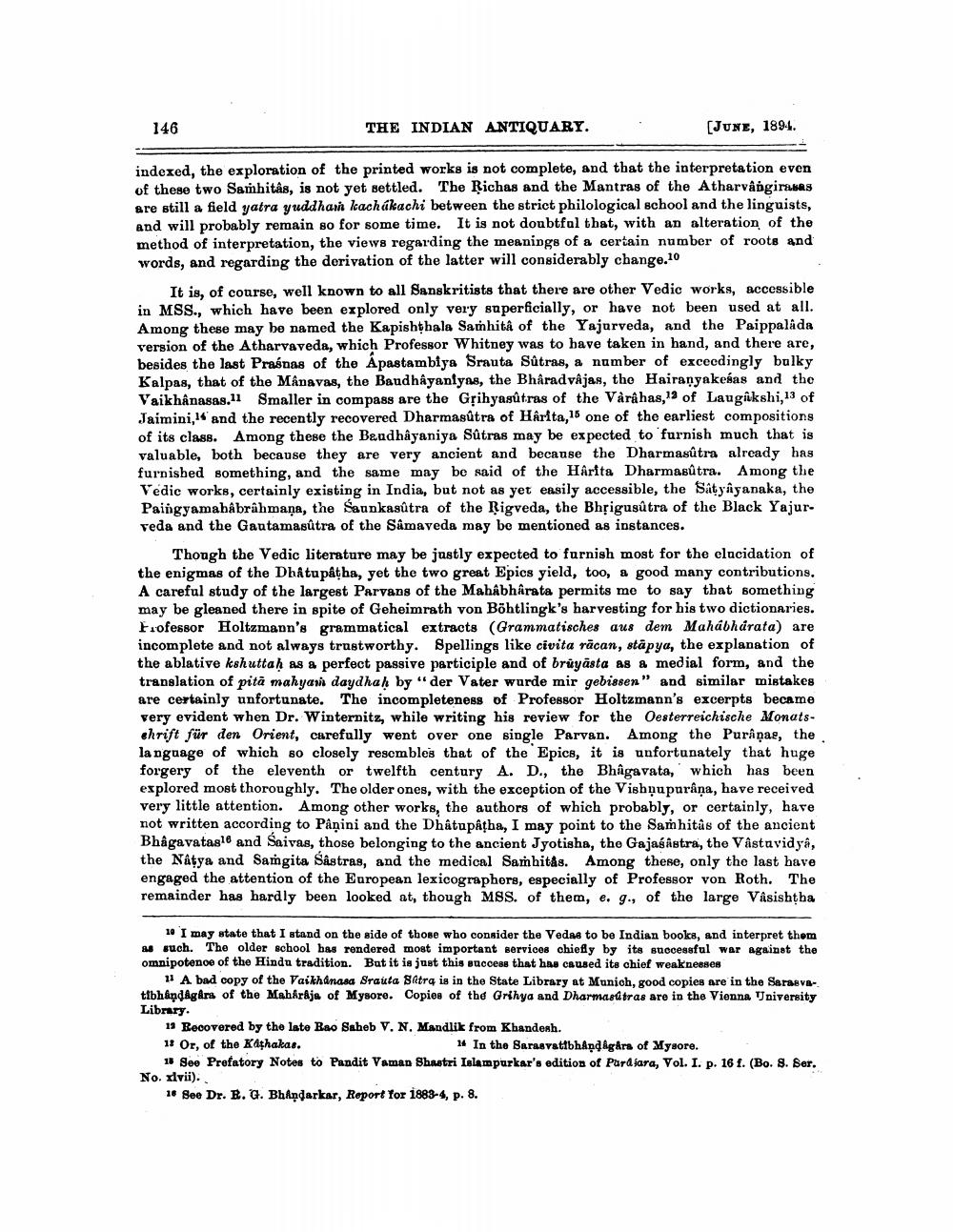________________
146
THE INDIAN ANTIQUARY.
(JUNE, 1894.
indexed, the exploration of the printed works is not complete, and that the interpretation even of these two Samhitas, is not yet settled. The Richas and the Mantras of the Atharvâögirakas are still a field yatra yuddhan kachakachi between the strict philological school and the linguists, and will probably remain so for some time. It is not doubtful that, with an alteration of the method of interpretation, the views regarding the meanings of a certain number of roots and words, and regarding the derivation of the latter will considerably change.10
It is, of course, well known to all Sanskritists that there are other Vedic works, accessible in MSS., which have been explored only very superficially, or have not been used at all. Among these may be named the Kapishthala Samhita of the Yajurveda, and the Paippalada version of the Atharvaveda, which Professor Whitney was to have taken in hand, and there are, besides the last Praśnas of the Apastambiya Srauta Sûtras, a number of exceedingly bulky Kalpas, that of the Manavas, the Baudhayanlyns, the Bhâradvajas, the Hairanyakeśas and the Vaikhanasas.11 Smaller in compass are the Gșihyasútras of the Våra has," of Laugîkshi,13 of Jaimini," and the recently recovered Dharmasútra of HÁrita, 15 one of the earliest compositions of its class. Among these the Bandhayaniya Sûtras may be expected to furnish much that is valuable, both because they are very ancient and because the Dharmasútra already has furnished something, and the same may be said of the Harita Dharmasútra. Among the Vedic works, certainly existing in India, but not as yet easily accessible, the Satyayanaka, the Paingyamahabrâhmaņa, the Saunkasútra of the Rigveda, the Bhřigusútra of the Black Yajurveda and the Gantamasútra of the Samaveda may be mentioned as instances.
Though the Vedic literature may be justly expected to furnish most for the elucidation of the enigmas of the Dhatupátha, yet the two great Epics yield, too, a good many contributions, A careful study of the largest Parvans of the Mahabharata permits me to say that something may be gleaned there in spite of Geheimrath von Böhtlingk's harvesting for his two dictionaries. Frofessor Holtzmann's grammatical extracts (Grammatisches aus dem Mahabharata) are incomplete and not always trustworthy. Spellings like civita rācan, stäpya, the explanation of the ablative kshuttah as a perfect passive participle and of brüyāsta as a medial form, and the translation of pitä mahyari daydhah by "der Vater wurde mir gebissen" and similar mistakes are certainly unfortunate. The incompleteness of Professor Holtzmann's excerpts became very evident when Dr. Winternitz, while writing his review for the Oesterreichische Monatschrift für den Orient, carefully went over one single Parvan. Among the Purâņas, the la nguage of which so closely resembles that of the Epics, it is unfortunately that huge forgery of the eleventh or twelfth century A. D., the Bhagavata, which has been explored most thoroughly. The older ones, with the exception of the Vishņupurâņa, have received very little attention. Among other works, the authors of which probably, or certainly, have not written according to Paņini and the Dhâtupațha, I may point to the Samhitûs of the ancient Bhagavatas18 and Saivas, those belonging to the ancient Jyotisha, the GajaśAstra, the Våstavidya, the Natya and Samgita Sastras, and the medical Sambitás. Among these, only the last have engaged the attention of the European lexicographers, especially of Professor von Roth. The remainder has hardly been looked at, though MSS. of them, e. g., of the large Vâsishtha
10 I may state that I stand on the side of those who consider the Vedas to be Indian books, and interpret them As such. The older school has rendered most important services chiefly by its Anccessful w omnipotence of the Hindu tradition. But it is just this success that has caused its chief weaknesses
11 A bad copy of the Vaikhanasa Srauta 8tra is in the State Library at Munich, good copies are in the Sarasvatibhåndagars of the Mahkraja of Mysore. Copies of the Grihya and Dharmasutras are in the Vienna University Library.
19 Recovered by the late Rao Saheb V. N. Mandlik from Khandesh. 11 Or, of the Kathakas.
14 In the Sarasvatibhånd Agårs of Mysore. 11 See Prefatory Notes to Pandit Vaman Shastri Islampurkar's edition of Parafara, Vol. I. p. 16 1. (Bo. S. Ber. No. xlvii).
16 See Dr. B. G. Bhandarkar, Report for 1883-4, p. 8.




